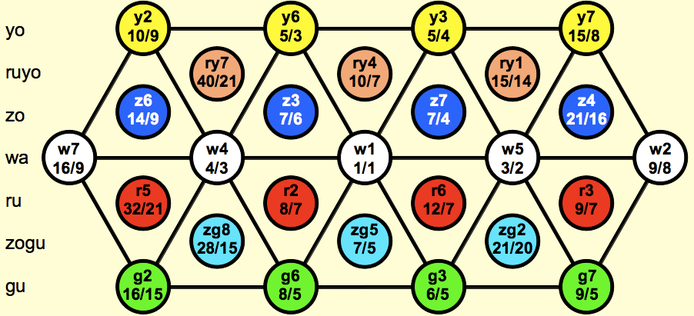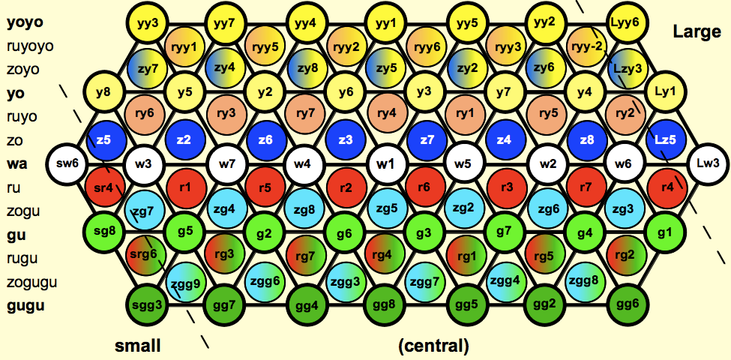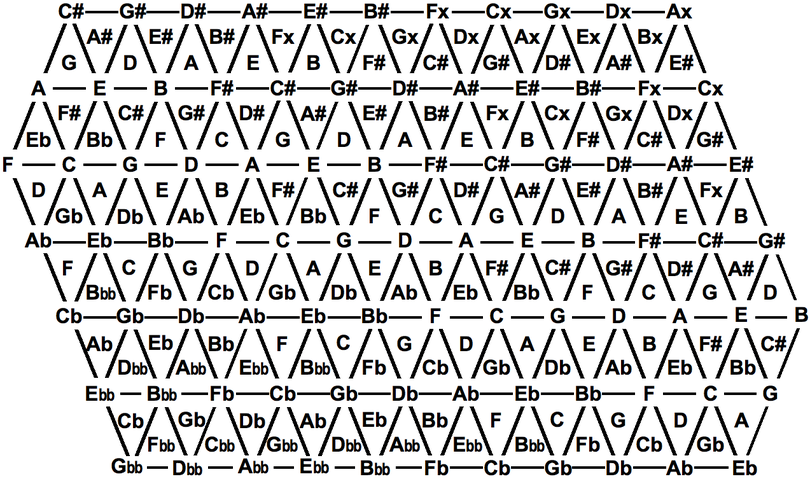Kite's color notation
This is a "crash course". For a full explanation, see Kite's book, "Alternative Tunings: Theory, Notation and Practice", available at www.TallKite.com.
Every prime above 3 has two color names, one for over (prime in the numerator) and one for under (prime in the denominator). Over colors end with -o, and under colors with -u. Here's the colors for primes 3, 5 and 7:
Wa = white (strong but colorless) = 3-limit
Yo = yellow (warm and sunny) = 5-over = major
Gu ("goo") = green (not as bright as yellow) = 5-under = minor
Zo = blue/azure (dark and bluesy) = 7-over = subminor
Ru = red (alarming, inflamed) = 7-under = supermajor
The colors come in a red-yellow-green-blue rainbow, with warm/cool colors indicating sharp/flat intervals. The rainbow of 3rds runs 9/7 - 5/4 - 6/5 - 7/6. Azure is used instead of blue because b looks like a flat sign. Mnemonic: Z looks like 7 with an extra line on the bottom.
Prime Subgroup Names
Just as wa means 3-all or 3-limit, ya means 5-all and includes wa, yo, gu, yoyo, gugu, etc. Ya = the 2.3.5 subgroup = 5-limit. Za = 7-all = 2.3.7. Yaza = 2.3.5.7 = 7-limit. Yaza nowa = 2.5.7.
Prime 2 (even more colorless than wa) is clear, abbreviated ca, and yaza noca = 3.5.7. 2-limit intervals like 2/1 are called wa not clear, for simplicity.
Interval Names
A color and a degree indicates a ratio, and vice versa. Every ratio has a spoken name and a written name. For 3/2, they are wa 5th and w5. Colors and degrees always add up predictably: z3 + g3 = zg5 = zogu 5th. Zogu not guzo, higher primes always come first. Opposite colors cancel: y3 + g3 = w5.
The JI lattice consists of many lattice rows, each one a chain of 5ths. Each lattice row has its own color, and each color has its own lattice row.
21/10 = zogu 9th = zg9. 25/16 = yoyo 5th = yy5. 128/125 = triple gu 2nd = g32. 50/49 = double ruyo negative 2nd = rryy-2. It's a negative 2nd because it goes up in pitch but down the scale: zg5 + rryy-2 = ry4. Negative is different than descending, from ry4 to zg5 is a descending negative 2nd.
More remote intervals are large (fifthward) and small (fourthward), abbreviated L and s. Central means neither large nor small. The magnitude is found by adding up all the monzo exponents but the first, dividing by 7, and rounding off. 0 = central, 1 = large, 2 = double large, etc. 81/64 = Lw3, 135/128 = Ly1. Magnitudes do not add up predictably like colors and degrees do: w2 + w2 = Lw3.
A comma is 10-50¢, a minicomma is 1-10¢, and a microcomma is 0-1¢. This allows us to omit the magnitude in the spoken name. Thus sgg2 is not the small gugu 2nd, but simply the gugu comma. The double-large wa negative 2nd (the pyth comma) is simply the wa comma. 81/80 = g1 is the gu comma. LLg-2 = g1 + LLw-2 is also gu and also a comma, but it's not the gu comma , because its odd limit is so much higher.
See Gallery of Just Intervals for more examples of interval names.
Note Names
Notes are named zE♭, yyG#, etc. spoken as "zo E flat", "yoyo G sharp". Notes are never large or small, only intervals are. Uncolored notes default to wa. The relative-notation lattice above can be superimposed on an absolute-notation lattice to name every note. Thus D + y3 = yF#, and from yE to ryF# = r2.
Chord Names
Triads are named after their 3rd, e.g. Cy. "Yo C" is a note, "C yo" is a chord. The four main yaza triads:
If the root isn't wa, the root color is added to the interval color: yo A gu = yAg = yA + (w1 g3 w5) = yA + wC + yE.
Tetrads are named Cy6, Dg7, etc. The 11 main yaza tetrads, with chord homonyms (same shape, different root) equated:
The y,z7 chord is also called the h7 chord ("aitch-seven"), because it's part of the harmonic series. The s7 ("sub-seven") chord is part of the subharmonic series. It's the first 7 subharmonics, with the 3rd subharmonic becoming the root. Note that s7 has no 7th. There are h9 chords, s11 chords, etc.
Alterations are in parentheses, additions never are. Example: Ch7(zg5)zg9 = C yE zgG♭ zB♭ zgD♭. Omissions are indicated by "no", as in Ch11no3. In harmonic and subharmonic chords, the 3 refers to the degree, not the 3rd harmonic. However numbers ≥ 15 always refer to (sub)harmonics, as in Ch15.
An 11th implies a 3rd, 5th, 7th and 9th. A 13th implies all these plus an 11th. The color of the 6th, 7th, and/or the 11th defaults to the color of the 3rd: The 5th, 9th and 13th default to wa. A y13 chord = w1 y3 w5 y7 w9 y11 w13. But an add 11 chord defaults to a wa 11: Cz7,11 = w1 z3 w5 z7 w11
Chord Progressions
The tonic is always wa. The root of each chord has a color, which defaults to wa. C - Am - F - G would be Cy - yAg - Fy - Gy.
In relative notation, the I, IV and V chords default to a wa root. II, III, VI and VII must have an explicit root-color. gCy - gGy - Ag becomes gIIIy - gVIIy - Ig.
Staff notation
Every non-wa note is marked with a color accidental like g, ry, etc. Like sharp/flat accidentals, they apply to every such note in the measure. D and D♭ are not similar. Here's Ih7 -- IVh7 -- Ih7 -- Vh9 in B♭:
Unlike regular accidentals which apply to a note (e.g. A), color accidentals only apply to one specific "version" of that note (e.g. A flat or A natural). For example, the yellow accidental in the first chord applies to all the D naturals in that measure but not to the D flats. Like regular accidentals, color accidentals only apply to one octave.
Keys are named after the colors used, the above is B♭ zo yo. Analogous to the relative and parallel major or minor, there is relative gu, parallel ru, etc.
Higher Primes
Colors for primes > 7 are named after the number itself:
Lova = 11-over, lu = 11-under, la = 11-all = 2.3.11. (Lova not lo, because "lo C" sounds like "low C".) Lova and lu are abbreviated to 1o and 1u on the score and in interval names and chord names, e.g. lova A = 1oA, lova 4th = 1o4 = 11/8 and C lova-7 = C1o7 = 1/1 - 11/9 - 3/2 - 11/6. The associated color is lavender (mnemonic: "e-leven-der"), which is a pseudocolor referring to both lova and lu, since they are only 7.1¢ apart (e.g. lo 3rd = 11/9 and lu 3rd = 27/22). More precisely, lova notes are lovender, and lu notes are luvender.
Tho = 13-over, thu = 13-under, tha = 13-all. Tho and thu are abbreviated as 3o and 3u on the score and in interval names, e.g. 13/8 = 3o6 = tho 6th.
Yala = 2.3.5.11, yazalatha = 2.3.5.7.11.13 = 13-limit, and yalatha nowa = 2.5.11.13.
While the note 11/8 from C can be written two ways, either as 1oF or as 1oF#, the interval 11/8 can only be written one way, as 1o4. Likewise, C + 13/8 is either 3oA or 3oA♭, but 13/8 is only 3o6. This is the rationale for using large/small rather than major/minor. Intervals names and chord names become unambiguous for la and tha intervals.
So = 17-over, su = 17-under, sa = 17-all, abbreviated as 17o and 17u. Sova is an alternate form of so, to distinguish it from the solfege syllable Sol.
Nova = 19-over, nunda = 19-under, na = 19-all, abbreviated as 19o and 19u. Nova because "no 3rd" could mean either 19/16 or thirdless. Nunda because "the nu key" sounds like "the new key".
Twenty-tho = 23-over, twenty-thu = 23-under, twenty-tha =23-all, abbreviated as 23o and 23u.
Twenty-no/-nu/-na = 29, thirty-wo/-wu/-wa = 31, thirty-so/-su/-sa = 37, etc.
The alternate forms with -ova or -unda are only needed when the color word appears alone. Thus 11/7 = loru 5th, not lovaru 5th.
Temperament Names
Temperaments are named after the color of the comma(s) they temper out. Meantone = the green temperament = gT. 5-limit Porcupine = triple yo = y3T. 7-limit porcupine = triple yo and ru = y3&rT. The magnitude is part of the name: Schismic is LyT. The degree is as well, if the comma is not the smallest of the 7 ratios of that magnitude and color: Mavila is Ly1T and Father is g2T. The temperament name indicates the prime subgroup and the rank of the temperament. ryyT is rank-3 because it has 2 explicit colors ru and yo, and 2 implicit colors wa and ca, and 4 colors minus 1 comma = rank-3.




